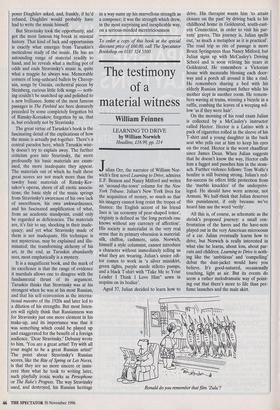The testimony of a material witness
William Feinnes
LEARNING TO DRIVE by William Norwich Headline, £16.99, pp. 214 Julian Orr, the narrator of William Nor- wich's first novel Learning to Drive, admires E.F. Benson and Nancy Mitford and writes an 'around-the-town' column for the New York Tribune. Julian's New York lives for the acquisition of money, so much so that his imagery cannot long resist the tropes of finance: the English accent of his friend Ines is 'an economy of pear-shaped tones', virginity is defined as 'the long periods one knows without any currency of affection'. His society is materialist in the very real sense that its primary obsession is material: silk, chiffon, cashmere, satin. Norwich, himself a style columnist, cannot introduce a character without immediately telling us what they are wearing. Julian's senior edi- tor comes to work in 'a silver miniskirt, green tights, purple suede stiletto pumps, and a black T-shirt with "Take Me to Your Leader I Think I Love Him" sewn in sequins on its bodice'.
Aged 37, Julian decided to learn how to drive. His therapist wants him `to attain closure on the past' by driving back to his childhood home in Goldenrod, south-east- ern Connecticut, in order to visit his par- ents' graves. This journey is, Julian spells out, `as much a metaphor as it is practical'. The road trip as rite of passage is more Bruce Springsteen than Nancy Mitford, but Julian signs up with McCauley's Driving School and is soon reliving his years in Goldenrod. He remembers a Victorian house with mezuzahs blessing each door- way and a porch all around it like a rind. He remembers sharing a bed with his elderly Russian immigrant father while his mother slept in another room. He remem- bers waving at trains, winning a bicycle in a raffle, combing the leaves of a weeping wil- low 'as if they were hair'.
On the morning of his road exam Julian is collected by a McCauley's instructor called Hector. Hector is a Latino with a pack of cigarettes rolled in the sleeve of his T-shirt and a young daughter in the back seat who yells out at him to keep his eyes on the road. Hector is the worst chauffeur since James Dean. When Julian suggests that he doesn't know the way, Hector calls him a faggot and punches him in the stom- ach. Further violence follows: Tom Wolfe's bonfire is still burning strong. Julian's red- for-success tie offers little protection from the 'marble knuckles' of the underprivi- leged. He should have worn armour, not Armani. We half-think that Julian deserves this punishment, if only because we've heard him use the word 'verily'.
All this is, of course, as schematic as the shrink's proposed journey: a small con- frontation of the haves and the have-nots played out in the very American microcosm of a car. Julian eventually learns how to drive, but Norwich is really interested in what else he learns, about loss, about par- ents and children. Learning to Drive is noth- ing like the `ambitious' and 'compelling' debut the dust-jacket would have you believe. It's good-natured, occasionally touching, light as air. But its events do seem a rather melodramatic way of point- ing out that there's more to life than per- fume launches and the male skirt.
Ronald do you remember that film 'Zulu'?


















































































 Previous page
Previous page